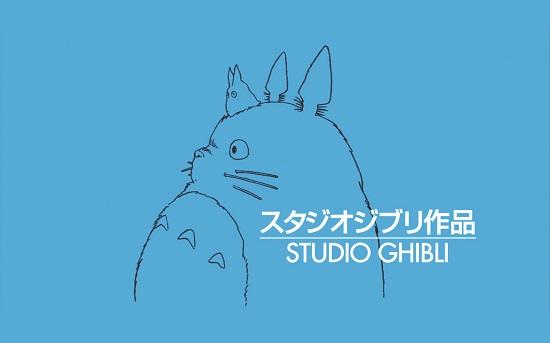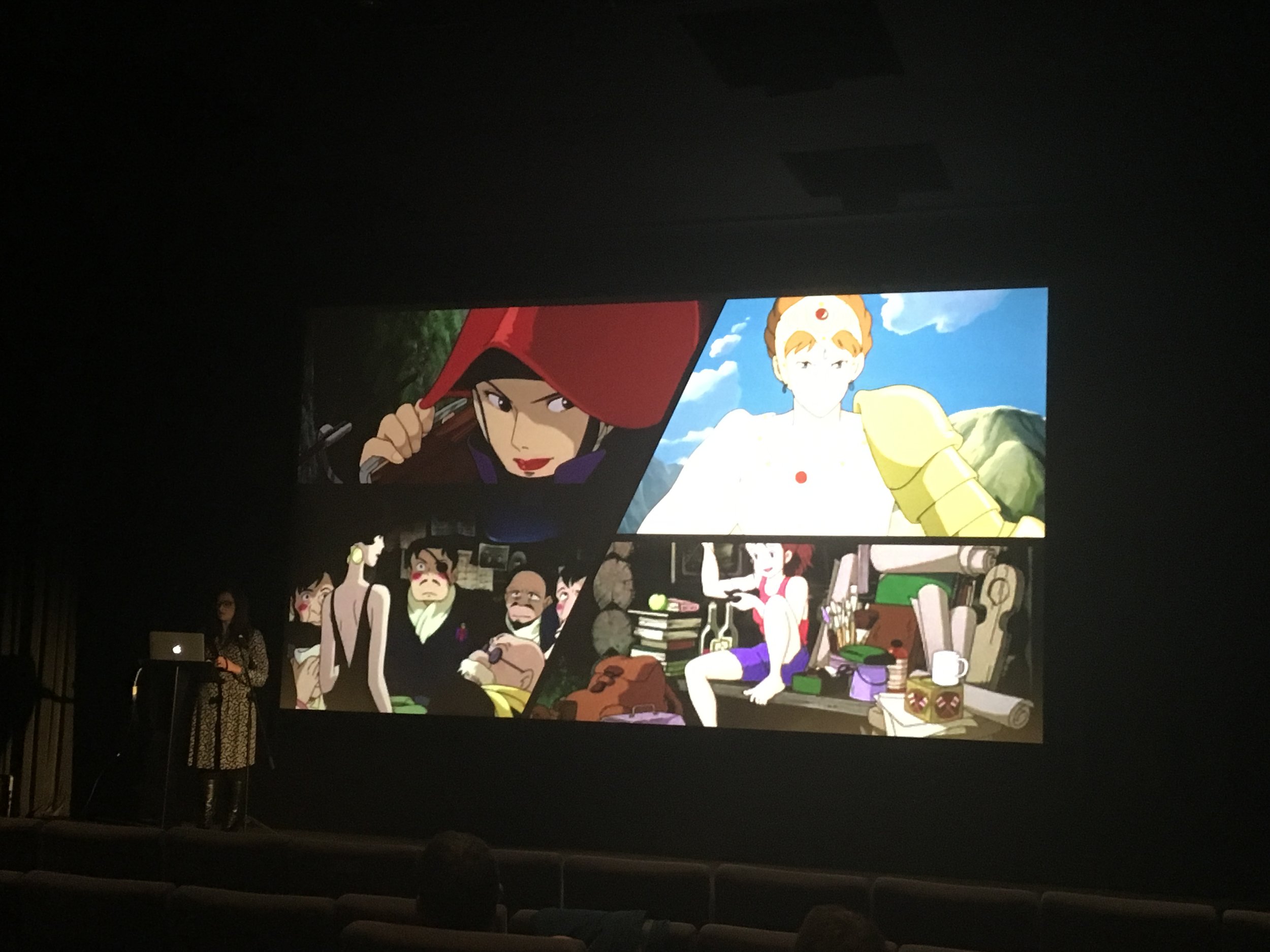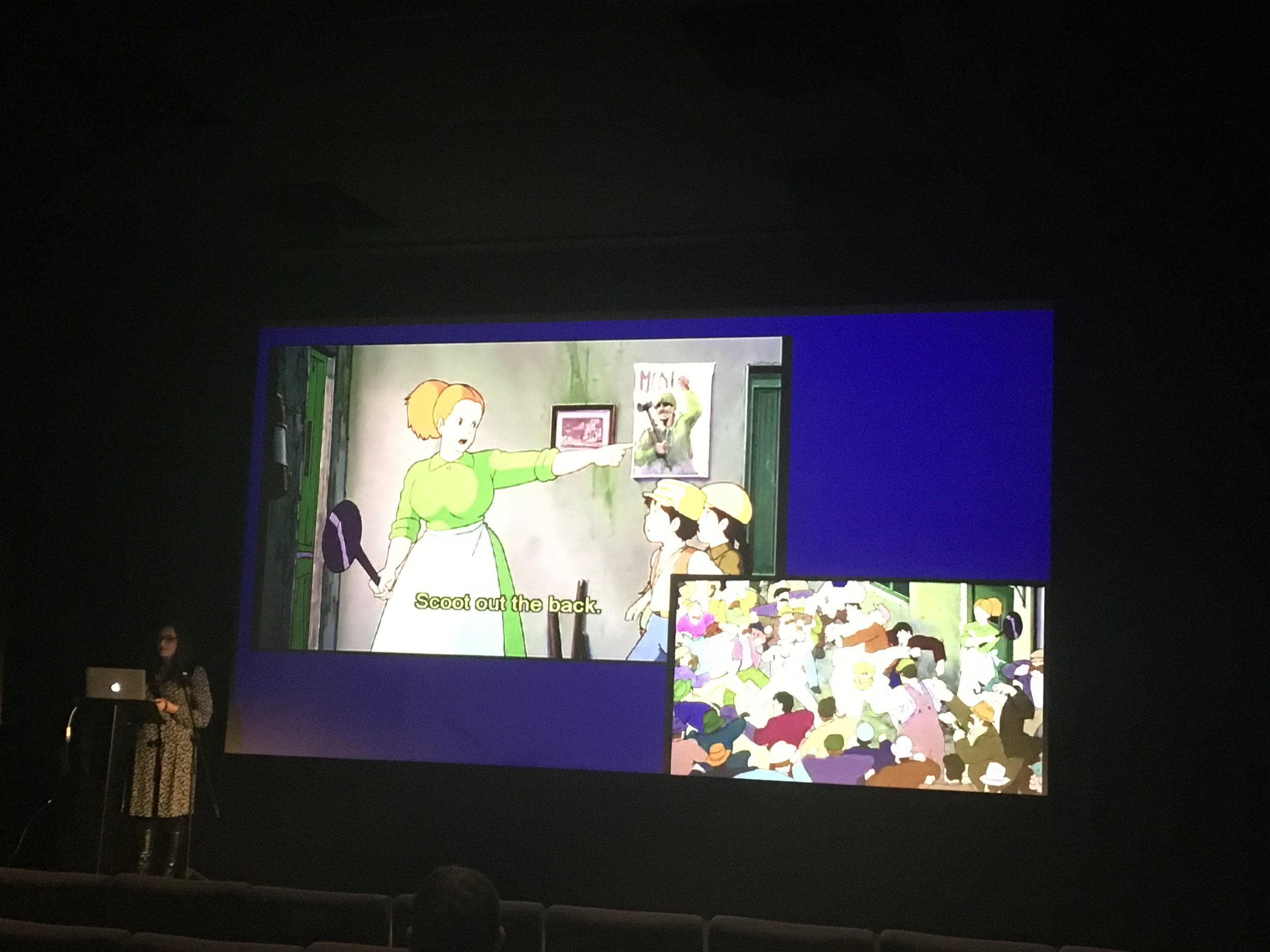Review: Eyes Unclouded - The Films of Hayao Miyazaki and Studio Ghibli
An academic conference on the key creative figures and animated feature films of renowned Japanese production house Studio Ghibli seems an obvious - even borderline ideal - candidate for working through the interplay between fantasy and animation. Our earlier podcast on their third cel-animated feature My Neighbor Totoro (Hayao Miyazaki, 1988) - whose primary spirit character Totoro now functions as the company’s logo image (Fig.1) - suggested just how much there was to say not only about the adventures of the eponymous creature, but the studio’s origins and evolution, production practices, and their relationship to anime as a creative medium, if not Ghibli’s longstanding critical repute and ongoing commercial acclaim. So then to the Eyes Unclouded - The Films of Hayao Miyazaki and Studio Ghibli event, held at the Depot Cinema in Lewes, East Sussex on Wednesday 8th May, and part of the 2019 University of Sussex Contemporary Directors series. Organised by Luke Robinson (University of Sussex), the one-day Eyes Unclouded was a whistle-stop tour through all things Japanese anime, doing so with impressive economy and precision whilst opening up some intriguing new avenues for something closely resembling ‘Ghibli studies’, and offering some real shifts in critical focus that placed Studio Ghibli, its key personnel, and its feature films in a variety of new scholarly contexts.
The symposium opened in typically strong and superlative fashion, with an impressive keynote from Rayna Denison (UEA), foremost anime scholar and author of several books on the history and shape of Japanese anime, such as Anime: A Critical Introduction (London: Bloomsbury, 2015) and the recently-published edited collection on Princess Mononoke (Hayao Miyazaki, 1997) as part of Bloomsbury’s own Animation Key Films series (Fig. 2). Denison’s keynote speech sought to connect up female representation onscreen to certain ‘invisible’ industrial structures, thereby bringing out elements of the studio’s working practices that perhaps get left behind, all the while allowing for a more nuanced consideration of Ghibli’s authorial signatures and the larger ‘deployment’ of women within the studio’s animated canon. The main timeframe for Denison’s focus encompassed the Ghibli feature films released in the six-year period between Castle in the Sky (Hayao Miyazaki, 1986) and Porco Rosso (Hayao Miyazaki, 1992), a formative period in the studio’s history that provided ample material for considering the vexed question of Ghibli’s feminism. Denison began by arguing that Ghibli’s repeating figure of the shōjo - a teenage female heroine on the cusp of womanhood - certainly indicates the richness of female characters painted with a degree of centrality across the studio’s features. From Kiki’s Delivery Service (Hayao Miyazaki, 1989) to Sophie in Howl’s Moving Castle (Hayao Miyazaki, 2004), the shōjo permits an examination of Miyazaki as cultural commentator (reflecting shifts in Japanese culture and in femininity in Japan); the issue of source material and Ghibli’s fairytale adaptations across time; and Miyazaki’s own themes and auteur status (such as the role of flight that he widely connects up to the shōjo’s movement onscreen). Yet moving beyond the dominating presence of the shōjo that has tended to overwhelm the discussion of Ghibli femininity, Denison made a call to arms asking where else we might look for feminine representation (Fig. 2, and see right). This necessitated something of a critical reorientation - firstly, towards Ghibli’s more marginal and incidental women. For example, the studio’s older, more complex female characters - such as Obaba in Nausicaä of the Valley of the Wind (Hayao Miyazaki, 1984), Granny in My Neighbor Totoro, Grandmother Okajima in Only Yesterday (Isao Takahata, 1991) or Yubaba and Zeniba in Spirited Away (Hayao Miyazaki, 2002) - function as politically-charged and ideological spaces to engage with power and agency. These ‘rule-breakers’, for Denison, are radical sites of meaning insofar as they subsist as and offer typically empowered outsider forms of female leadership. Another useful example of where we ‘see’ femininity in Ghibli beyond the shōjo archetype occurs within the social critique of Porco Rosso. As Denison argued, active women labourers are depicted as mobile and in co-operation in ways that highlight the sexism of dubious males (drawn as ‘piglike’ anthropomorphs, unlike the more ‘classical’ female workers) (for an analysis of this scene and others, see the 2017 piece titled “The Women of Studio Ghibli” published on the Society for Animation Studies blog). Secondly, thinking through Ghibli’s women also requires a methodological move towards labour and industry, and the behind-the-scenes practical support offered by Miyazaki towards female animators and production staff within the industrial structure’s of Studio Ghibli as a company. The focus for Denison here was Miyazaki’s implementation of rolling contracts, the addition of a creche and similar childcare facilities onsite to support working mothers, and even managing the size of the women’s restroom at the Ghibli complex in Tokyo. Denison pointed out that despite criticisms of Miyazaki’s particular brand of feminism as still framed by patriarchy and socialist visions, his feature films and those of Studio Ghibli more broadly, as well as wider industrial considerations, may function as entry points into - and key indicators of - how extensive the filmmaker’s ‘worlds of women’ might ultimately be.
The first of the day’s two panels comprised a line-up of speakers largely invested in the cultural reception of Miyazaki and Ghibli, as well as connections between the films and questions of national identity and tradition (Fig. 3). Katherine Whitehurst (University of Liverpool) discussed childhood as an intermediary that brings together Japaneseness with articulations of individualism, collectivism and neoliberalism. Whitehurst examined the fantasy world of Spirited Away as one of neoliberal economics, placing Ghibli in the throes of globalisation whilst restating the historical importance of the child as a central tool in nation-building. Whitehurst sought to strengthen the critical discourse between the child and the nation, using Ghibli’s narratives as a marker for how such an interrelation might play out. Kalvin Schmidt-Rimpler Dinh (University of Cambridge) offered a more philosophical reading of Ghibli’s animated features, channelling Miyazaki through a critical framework informed by the Anthropocene and ‘granular thinking’ - that is, a metaphorical approach invoked by Katrin Klingan (2015) that approves a more textural way of thinking. Bringing anthropomorphic clay figurines or Dogū (humanoid and animal figurines from the Jōmon period) together with both ideas of ‘deep time’ that fascinate anthropocenic thought and the Japaneses idea of ma (intervals or gaps that carry meaning), Schmidt-Rimpler Dinh argued that Ghibli’s films shift and transform through their thematic engagement with humanity and/as ecology. Christine York Hei Hui (University of Sussex) situated Ghibli and Miyazaki more explicitly within animation form and style, doing so by identifying the importance of Isao Takahata as a director whose work (more so than perhaps Miyazaki) draws on and perpetuates a national aesthetic. Engaging with cultural theorist Koichi Iwabuchi’s idea of “cultural odour” (2002: 27), Hei Hui analysed Takahata’s animated fantasy film The Tale of the Princess Kaguya (Isao Takahata, 2013) as a commodity that ‘smells’ as an elegy to Japan as a nation. As a result, The Tale of the Princess Kaguya is a film that can be examined according to a series of interlocking paradigms - animated fairytales within modern animation; nostalgia and the interplay of time and modernisation; and stylistic allusions to Japanese art that, for Hei Hui, represent a poeticisation of anxieties about the future and, thus, mark a desire to return to the ‘home village’ as a past space. Yet I wondered if the 2013 release of The Tale of the Princess Kaguya might also suggest alternate formal connections, reaching out to analogous Hollywood shifts in computer graphics at studios like Pixar that, at a similar moment, “pushed the boundaries of computer-generated animation to create digital images that resemble hand-drawn artwork, highlighting a nostalgic trend for the analogue” (Haswell 2015). The panel’s final paper was delivered by Robert Hyland (Queen’s University), who placed the folkloric and folk mythology into conversation with Ghibli’s animated works as a way of supporting a critical understanding of their national specificity. Hyland noted how folklore is traditionally a means of consolidating Japanese belief systems and the myth of Japanese homogeneity (the shared belief in Shinto of ujigami), and providing spiritual and moral guidance, before he turned in earnest to the work of folklorist Yanagita Kunio. Plotting a critical-historical path through Ghibli’s feature films, Hyland identified the stakes of Miyazaki’s folklorist aesthetic (as a filmmaker born and educated at the time of Kunio’s writings), and identified the role of fantasy (via the pervasiveness of the spiritworld or kakuriyo into the utsushiyo or actual world) in crafting a broader industrial meta-narrative of the folkloric that can be utilised as a way of analysing Ghibli as a mode.
Panel two (Fig. 4) continued the illuminating work of the previous session, with papers coming together under the guise of critical ‘positioning’, concerned as they were largely with issues of the marketing, form, and genre of Ghibli as an animation studio. The first speaker - Shiro Yoshioka (Newcastle University) - engaged with the promotional strategies of Ghibli by understanding the studio as ‘masters of branding’. Situating Ghibli’s feature films within flows of cultural production, Yoshioka spoke of Pierre Bourdieu’s ideas of (the acquisition of) cultural capital by Ghibli after the release of Kiki’s Delivery Service. Yoshioka argued that shifting media coverage of Ghibli has resulted in Miyazaki’s repeated “consecration” and assumptions around his artistic value as an auteur, maneouvring popular focus away from Miyazaki’s contribution to anime more generally onto his films’ specific content and themes. Pursuing a similar perspective drawn from critical reception studies, Francis Agnoli (UEA) took up residence in a so-called ‘post-Ghibli’ phase, looking at two animated fantasy films - The Red Turtle (Michaël Dudok de Wit, 2016) and Mary and the Witch’s Flower (Hiromasa Yonebayashi, 2017) - produced by companies affiliated with Ghibli, to look at the ways in which popular discourse in North America framed both films in relation to the studio. Mary and the Witch’s Flower was the debut of Studio Ponoc, founded by former Ghibli lead film producer Yoshiaki Nishimura in April 2015. As such, Agnoli found that in press reviews the film was commonly written about as an heir to Ghibli, or at the very least firmly in its stylistic and ideological shadow. By comparison, Agnoli found that The Red Turtle project was widely cited in reviews in ways that highlighted its ambivalent origins (as more of a European fable than an indigenous Japanese product), drawing particular focus for the nationality of its Dutch director Michaël Dudok de Wit. These findings promoted Ghibli themselves as both a critical framework available within popular discourse, and as a transcultural and transnational brand identity able to move fluidly into descriptions of other similar Japanese animated fantasy cinema. Herbert Schwaab (University of Regensburg), however, turned away somewhat from big-screen Ghibli to identify its ‘televisual’ qualities of narration. By looking at endings, seriality and discourses of repetition within Miyazaki’s work, Schwaab positioned the filmmaker amid the mechanisms of commercial television production, from the sitcom to the soap opera. Despite Miyazaki’s wider rejection of sequels (though there is a follow-up to My Neighbor Totoro, the 14-minute Mei And the Kittenbus viewable at the Studio Ghibli Museum in Tokyo), the question of the television medium’s influence on Ghibli was evidenced for Schwaab in the shared elements and continuities between productions, from character archetypes to repetitions in hybrid architecture. But Schwaab’s analysis was also framed by Miyazaki’s own little-known contributions to small-screen anime programmes Heidi, Girl of the Alps (Isao Takahata, 1974) and Anne of Green Gables (Isao Takahata, 1979) based on L. M. Montgomery’s 1908 children’s novel (Fig. 5). But if seriality invites continuity and, with it, suggestions of generic patterning, then the day’s final paper by Tom Mes (Leiden University) took this idea of the formula in new directions. Advocating for a modular rather than generic approach to understanding what we might know as a ‘Ghibli film’, Mes speculated on the future of the studio and the inherent challenges of the post-Miyazaki period via questions of legacy. For Mes, a modular approach identifies how a new Ghibli work could be reassembled from the same basic narrative and formal elements through Ghibli’s own self-structuring brand identity that is disconnected from the studio. While genre theorists such as Rick Altman (1999) and Steve Neale (2000) have taught us that genres are, of course, comprised not only of films but (Neale), Mes’ paper raised questions about the role of the modular versus broader generic classification (with the former being a nuancing of the latter), as well as how new Ghibli works could be engineered and ‘evoked’ beyond industry, and even beyond Takahata and Miyazaki’s hands-on influence.
These concluding critical assumptions of Studio Ghibli as an ‘assembly kit’ of codes rooted in key principles of composition neatly crystallised the strengths of an event that successfully interrogated Ghibli’s own workbook of forms. Impressive in their scope, papers touched on a range of topics that might have formed single symposia all on their own, including the fantasy of Ghibli’s screen worlds (and what ‘fantasy’ might mean in this non-Western context), vocal performance and international dubbing practices, as well as character design and background art that contribute to the recognisable Ghibli aesthetic. However, these areas were positioned as a complement (perhaps even a consequence) to more industry-led presentations that took in marketing, brand identity, auteurism and animation as a technology. Yet amid the celebratory rhetoric of this globally-renowned studio, speakers were right to make clear that Ghibli can be a frustrating industrial and stylistic object, with new critical paths often extremely overgrown and running wild in ways that might thwart scholarly travellers. Yet Eyes Unclouded presented scholarship equipped with entirely the right tools to find a way through this dense critical jungle. It was refreshing to hear panellists and their papers always wanting to move beyond, to complicate and problematise, and even render unsteady dimensions of Studio Ghibli previously thought of as altogether more firm and fixed. For an event that managed in just one day to touch on the studio’s transnational brand identity and uniqueness of form, its cultural politics of representation and its industrial structures - if not Ghibli’s resistance to easy scholarly categorisation - Eyes Unclouded, like Kiki, certainly delivered.
References
Altman, Rick. Film/Genre (London: BFI Publishing, 1999).
Haswell, Helen. “To Infinity and Back Again: Hand-drawn Aesthetic and Affection for the Past in Pixar’s Pioneering Animation,” Alphaville: Journal of Film and Screen Media (2015), available at: http://www.alphavillejournal.com/Issue8/HTML/ArticleHaswell.html.
Klingan, Katrin. Textures of the Anthropocene: Ray (Cambridge, MA: MIT Press, 2015).
Neale, Steve. Genre and Hollywood (London: Routledge, 2000).
Iwabuchi, Koichi. Recentering Globalization: Popular Culture and Japanese Transnationalism (Durham, N.C.: Duke University Press, 2002).









